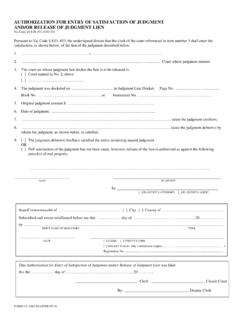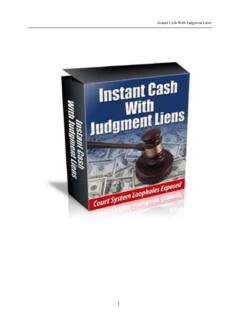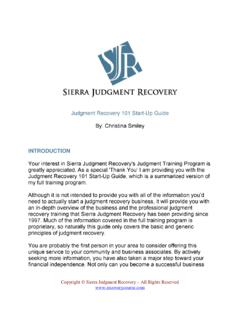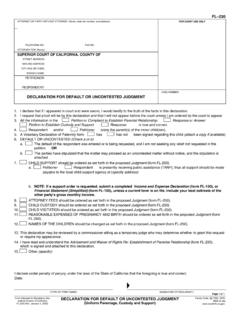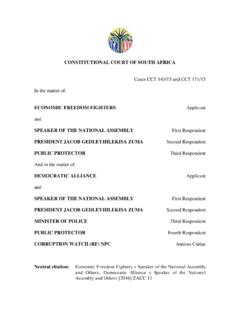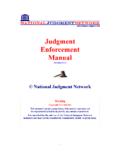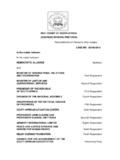Transcription of FEDERAL A. Summary Judgment Standard
1 1 FEDERAL A. Summary Judgment Standard The Standard which applies to Summary Judgment motions is by no means controversial, nor is it foreign to this tribunal. See Raskin v. Wyatt Co, 125 55 (2d Cir. 1997); Cronin v. Aetna Life Insurance Co., 46 196 (2d Cir. 1995). Summary Judgment is warranted when the pleadings, depositions, answers to interrogatories and admissions on file, together with the affidavits, if any, show that there is no genuine issue as to any material fact and that the moving party is entitled to Judgment as a matter of law. Fed. R. Civ. R. Civ. P. Rule 56(c). See Raskin, 125 at 60. This guiding principle applies with no less force in cases such as this where employment discrimination claims come under scrutiny on a motion for Summary Judgment .
2 See Goenaga v. March of Dimes Birth Defects Foundation, 51 14 (2d Cir. 1995); LaFond v. General Pysics Services Corp., 50 165 (2d Cir. 1995); Cronin, 46 at 202-203; Galla v. Prudential Residential Services, Ltd. Partnershipial Residential Services, Ltd. Partnership, 22 1219 (2d Cir. 1994). When analyzing a motion for Summary , it is incumbent upon the court to determine, as a threshold matter, whether there exists an issue of material fact requiring trial. Anderson v. Liberty Lobby, Inc., 477 242, 242-243, 106 S. Ct. 2505, 2511 (1986). A material fact is genuinely in dispute if the evidence is such that a reasonable jury could return a verdict for the non-moving party. Id.; Rovtar v. Union Bank of Switzerland, 852 F. Supp. 180, 182 ( 1994). In determining whether such a question of fact is raised, the court must make all credibility assessments, resolve any ambiguities, and draw all inferences, in favor of the non-moving party, and may grant the 2 motion only if the evidence, taken in that light, reflects that there is no genuine issue of material fact and that the moving party is entitled to Judgment as a matter of law.
3 Schwapp v. Town of Avon, 118 106, 110 (2d Cirri. 1997); Chambers v. TRM Copy Centers Corp., 43 29, 37 (2d Cirri. 1994). As noted, Summary Judgment should be cautiously granted in cases involving employment discrimination claims. Schwapp, 118 at 110. It is by now well established that Title VII of the Civil Rights Act of 1964, as amended ( Title VII ), 42 sec. 2000e et sego., can give rise to a hostile work enviornment claim based upon race. Schwapp, 118 at 10-111; West v Philadelphia Electric Co., 45 744 (3d Cirri. 1995); Erebia v. Chrysler Plastic Products Co., 772 1250 (6th Cirri. 1985), cert. denied, 475 1015, 106 S. Ct. 1197 (1986). See alsoTorres, 116 at 630-31; 29 sec. (EEOC Guidelines on Discrimination Because of Sex). Indeed, courts have long recognized that under Title VII an employment has a right to a working environment free of racial harassment.
4 Snell v. Suffolk County, 782 1094, 1096 (2d Cir. 1986). In its initial decision concerning claims of harassment in the workplace, the Supreme Court held that to be actionable under a hostile work enviornment theory the conduct at issue must be sufficiently servere or pervasive to alter the conditions of [the victim s] employment and create an abusive working enviornment> Meritor Savings Bank, FSB v. Vinson, 477 57, 67, 106 S. Ct. 2399, 2405 (1986). More recently, the Supreme Court clarified that in making this determination the factfinder must view the totality of the circumstances both from subjective and objective standpoints. Harris v. Forklift Systems, Inc., 510 17, 22, 114 S. Ct. 367, 370 (1993). See Schwapp, 118 3 at 110. In other words, taking into account the frequency of the discriminatory conduct, its severity, and whether it is physically threatening or humiliating or instead merely an offensive utterance, the plaintiff must show not only that the alleged harasser engaged in conduct which the plaintiff found to be hostile and abusive, but in addition that a reasonable person would perceive the conduct to be such.
5 Id. Obviously, this type of analysis is generally laden with questions of facts. In support of her hostile work environment claim plaintiff adduced proof. primarily in the form of her affidavit, that she was subject to repeat and continuous racial harassment. In plaintiff s affidavit, she detailed specific incidents of a racial nature occurring, all in her presence. Plaintiff s claims concerning the racially hostile environment, which existed, was substantiated not only by the many incidents which she suffered, but indeed the record of her complaints to supervisors. In Torres, supra, the court emphatically rejected the defendant-employer s claim that the plaintiff, who alleged sexual and race-based harassment occurring on a regular basis, but who could not only recall five specific incidents, was not entitled to avoid Summary Judgment and have a jury decide whether the conduct was sufficiently severe or pervasive as to constitute an abusive or hostile work enviornment.
6 166 at 631-33. In so ruling this court noted: The fact that the law requires harassment to be severe or pervasive before it can be actionable does not mean that employers are free from liability in all but the most egregious of cases Harassed employers do not have to be Jakie Robinson, nobly turning the other cheek and remaining unaffected in the face of constant degradation. They are held only 4 to a Standard of reasonableness. Whenever the harassment is of such quality or quantity that a reasonable employee would find the conditions of her employment altered for the worse. it is actionable under Title VII, so long as the employee subjectively experienced a hostile work environment. 116 at 631-32 (citations and footnotes omitted).
7 The Torres court concluded that there existed a jury question as to whether or not the conduct alleged created a hostile work environment. Id. As can be seen, plaintiff s allegations as to the working conditions which she faced in this case far surpass those involved in Torres in both number and seriousness. This case, by contrast, is analogous to Erebia v. Chrysler Plastics Products Corp., 772 1250 (6th Cir. 1985) cert. denied. 475 1015, 106 S. Ct. 1197 (1986) and Walker v. Ford Motor Co., 684 1355 (11th Cir. 1982). Use by the Supreme Court of the disjunctive serve or pervasive rather than the conjunctive severe and pervasive test implies that even a single incident, if sufficiently invidious, may suffice to establish the existence of an unlawful hostile working enviornment, as indeed many courts have recognized.
8 , Torres,. 116 at 631 ; Daniels v. Essex Group, Inc., 937 1264, 1274 (7th Cir. 1991); Taylor v Metzger, ____ ___, 1998 WL 63084 ( Sup. Ct. 1998) (discussing state and FEDERAL cases and finding that singular use of the term jungle bunny in the workplace was sufficient to avoid Summary Judgment ). See also Robert J. Gregory, You Can Call Me A Bitch Just Don t Use The N-Word : Some Thoughts On Galloway v. General Motors Servicee Parts Operations and Rogers v. WesternSouthern Life Insurance Co. , 46 DePaul L. Rev., 741, 748, (1997) ( courts have viewed racist epithets as beyond the pale, regardless of the prevalence of these epithets in the workplace. ). As the Seventh Circuit observed in 5 Daniels: The number of instanes of harassment is but one factor to be considered in the examination of the totality of the circumstances.
9 A Title VII plaintiff does not prove racial harassment or the existence of a hostile working enviornment by alleging some magic threshold number of incidents. Conversely, an employer may not rebut a claim simply by saying that the number of incidents alleged is too few. Daniel v. Essex Group, Inc., 937 1264, 1273-74 (7th Cir. 1991) While it is plausible that a jury hearing the evidence presented, might find that objectively it does not rise to the level of sufficiently severe or pervasive as to constitute an abusive working environment, the teaching of Torres and Schwapp is that it is for the jury, rather than the court as a matter of law, to make that determination. The courts having addressed the issue of employer liability for hostile work environment harassment claims have generally resorted to traditional agency principles, by imperfect analogy, for guidance.
10 See Torres, 116 at 633. See also. Kotcher v. Rosa & Sullivan Appliance Ctr., Inc., 957 59, 64 (2d Cir. 1992); Karibian v. Columbia University, 14 733, 780 (2d Cir. 1994), cert. denied, 512 213, 114 S. Ct. 2693 (1994). The test which has been formulated imputes liability to an employer in such circumstances where a) the harassment was performed by a sufficiently high ranking supervisor; b) the harassment was performed by a supervisor who used his or her actual or apparent authority to further the harassment in order to aid in the accomplishment of it; c) the employer provided no reasonable avenue for complaint concerning harassment; or d) the employer knew or should have known of the harassment, but unreasonably failed to stop it. Torres, 116 at 634.


